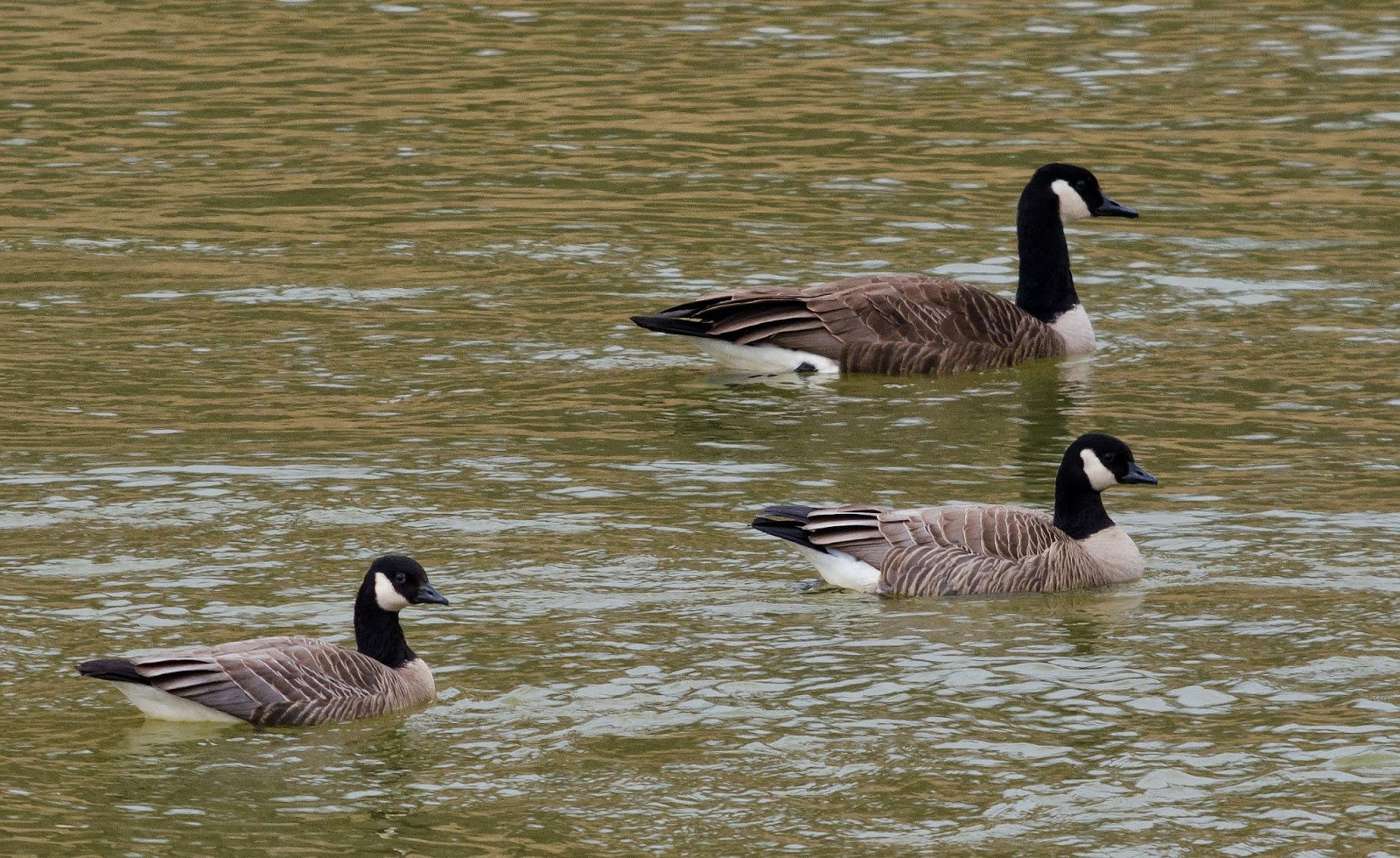Okay, so this is horribly overdue, but here it is nonetheless. The Sunday of February 8th, I decided to head up to The Ridges, an Ohio University owned hiking complex on the edge of Athens in Athens County, to do some birding. It was a good trip for mid winter, but the real surprises of the day were found when I was walking back to Ohio University. As I was crossing the Hocking River, I decided to scope out the larger and ever-present resident population of Canada Geese. A local birder had found two Greater White-Fronted Geese a few days prior, and although I didn't think they would still be hanging around, why not look?
I relocated them within 30 seconds, much to my surprise. After a few obligatory seconds of freaking-out-over-a-lifer, I crossed the bridge and decided to get a better view. So why all this hoopla over a goose? Well, the Greater White-Fronted Goose is a pretty rare visitor to Ohio. When they do show up here, it's mainly in the glaciated portions of western Ohio and along Lake Erie; to have not one, but two, show up in southeastern Ohio, in a pretty urban area, was really unexpected.
The Greater White-Fronted Goose, Anser albifrons, is a goose of the west. The North American populations (they are also found in Eurasia) breed on the tundra of Alaska and northern Canada. They overwinter in disjunct regions in the southern US and Mexico, including the Central Valley of California along with southeastern Texas and Louisiana. They migrate mainly along the Pacific and Central Flyways. The Central Flyway goes up and down the Great Plains region. If you haven't noticed yet, they're a little out of place here in Athens, Ohio. Although they are a bird found mainly west of the Mississippi River, a few individuals do stray east into Ohio every year.
The Greater White-Fronted Goose is a relatively small goose. Compare the size of the Canada Geese with the White-Fronted in the photo above to get an idea of the size. I knew they were smaller, but their size honestly surprised me when I saw them. They were just so dainty!
These geese are sometimes nicknamed "Specklebellies" here in the US. The dark bands and speckles going across the breast, as seen above, give rise to this name. You might also be wondering about the "Greater" in their common name as well. If there is a Greater White-Fronted Goose, is there a Lesser? There is indeed a Lesser White-Fronted Goose, but they are not found here in North America. Greater White-Fronted's are circumpolar breeders, meaning they breed all around the northern half of the world, including Canada, Alaska, Greenland, and Siberia. Lesser White-Fronted Geese are restricted to Eurasia, breeding primarily in northern Asia. They are superficially similar to the Greater White-Fronted, with the biggest difference being their smaller size. For some reason in the geese, "dwarf species" have arose several times. For example, the Greater and Lesser White-Fronted Geese, Snow and Ross's Geese, and Canada Geese and Cackling Geese.
Interestingly, these two individuals stuck around Athens for awhile. I assumed they would try to move on relatively quickly, but they were repeatedly found for about 3 or so weeks total.
After watching the Greater White-Fronted Geese for awhile, I decided to scan the rest of the river to see if there were any ducks hanging around. Of the near 100 Canada Geese hanging around, two immediately made me stop scanning. My mind started racing; could those two small geese be what I thought they were? Could it really be that the Hocking River not only held one rare species that day, but two? Could they really be Cackling Geese, yet another lifer for me?
I looked over their field marks: Tiny, Mallard-like size? Check. Short, stubby neck? Check. Squarish forehead with a very short beak? Check. Yes! It was a Cackling Goose, Branta hutchinsii! I was completely amazed; not only was I lucky enough to relocate the rare Greater White-Fronted Geese, but I also found two Cackling Geese to boot! Cackling Geese are another species of western geese that occasionally visit Ohio each winter. They breed along the Arctic tundra and migrate primarily through the Great Plains and down the Pacific coast, overwintering in both Texas/New Mexico and California/Oregon/Washington, respectively. Most of the individuals that move through Ohio are found in the western half of the state, especially near Lake Erie. Finding two in Athens County was yet another unexpected treat.
The Cackling Goose is a "newer" species. Up until 2004, the Cackling Goose was considered one of the many subspecies of the Canada Goose. Some research concluded that it was indeed a different species, a relatively common occurrence. Many subspecies get elevated to the species level, and sometimes two or more species are lumped together into one species. The act of lumping and splitting species has especially increased with the rise of genetic studies in the past decade. More genetic research has found that there are a number of highly distinct subspecies of the Cackling Goose, so future studies might even result in a further split.
The semester is winding down for me, with only about a month to go! This semester has been crazy, making it really hard to find time to blog. Hopefully this summer brings me more time to write. I will be spending the first half of my summer in northern Ohio doing more salamander research, and I am very excited for that. The second half of my summer will be spent in either New Mexico for an internship, or back in Athens for snake research. I'm hoping that I'll come across some awesome stuff to write about since most of my summer will be spent outside! Thanks for reading!







